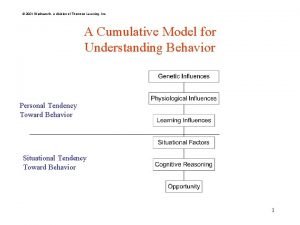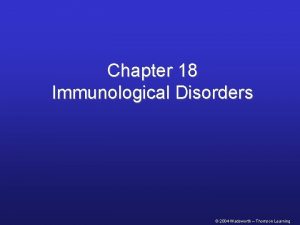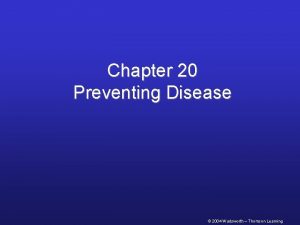Chapter 27 Systemic Infections 2004 Wadsworth Thomson Learning


























- Slides: 26

Chapter 27 Systemic Infections © 2004 Wadsworth – Thomson Learning

Organs of the Cardiovascular and Lymphatic Systems Figure 27. 1 © 2004 Wadsworth – Thomson Learning

Infections of the Heart • Carditis – inflammation of heart tissue – endocarditis--epithelial and connective (valves) • subacute bacterial endocarditis ( -hemolytic strep) • acute bacteria endocarditis (S. aureus and S. pyogenes) © 2004 Wadsworth – Thomson Learning

Infections of the Heart – Myocarditis • cardiac muscles • Viral myocarditis – coxsackievirus • American Trypanosomiasis (Chagas’ disease) • Trypanosoma cruzi – animal and insect hosts – Pericarditis • • membrane surrounding heart usually viral Streptococcus spp. Staphylococcus spp. © 2004 Wadsworth – Thomson Learning

Systemic Bacterial Infections • Plague – Yersinia pestis – bubonic • bubos--inflamed lymph nodes – septicemic plague • • bloodborne tissue necrosis skin blackened Black death – pneumonic plague • lung infection © 2004 Wadsworth – Thomson Learning

Systemic Bacterial Infections • Tularemia – Francisella tularensis • vector: deer fly in SW/wood tick NW and Midwest • direct contact: ingest/handle, rabbits • highly virulent • ulceroglandular tularemia – small sore at entrance – swelling in surrounding lymph node – multiply in phagocytes • symptoms – high fever, chills, headache, possibly pneumonia © 2004 Wadsworth – Thomson Learning

Systemic Bacterial Infections • Brucellosis – several Brucella species • domestic animals • Pasteurization • symptoms: – undulating fever – disoriented © 2004 Wadsworth – Thomson Learning

Systemic Bacterial Infections • Lymes Disease – – – Borrelia burgdorferi Spirochete tick born: Ixodes species animal reservoir 1975 Lyme, Connecticut • cluster of pediatric arthritis – three phases • bulls eye rash--75% of cases • headache, stiff neck, muscle aches, fatigue • eventually arthritis © 2004 Wadsworth – Thomson Learning

Systemic Bacterial Infections • Relapsing Fever – Borrelia spp. – Symptoms • sudden onset of fever, slowly subsides • week later, symptoms reappear – Antigenic variation • type-specific antibodies during fever • bacteria are cleared • alter surface antigens and reappear – Epidemic relapsing fever – Endemic relapsing fever © 2004 Wadsworth – Thomson Learning

Systemic Bacterial Infections • Anthrax – Bacillus anthracis • spore former • three exotoxins – symptoms – domestic and wild animals – humans • cutaneous anthrax • respiratory anthrax • gastrointestinal anthrax Figure 27. 6 © 2004 Wadsworth – Thomson Learning

Systemic Bacterial Infections • Cat Scratch Disease – Bartonella bonselae – symptoms • swollen lymph gland – arm or groin • healing scratch marks on same limb © 2004 Wadsworth – Thomson Learning

Systemic Bacterial Infections • Typhus – epidemic typhus • Rickettsia prowazekii – vector: lice from human to human/crowded conditions – murine typhus • Rickettsia typhi – vector: flea from mouse/rat, endemic – scrub typhus • Rickettsi tsutsugamushi • Asia and SW pacific – WWII and Vietnam War © 2004 Wadsworth – Thomson Learning

Systemic Bacterial Infections • Rocky Mountain Spotted Fever – Rickettsia rickettsii – wood tick – dog tick – Lone Star tick – symptoms • spotty rash • abnormal clotting Incidence of cases within the U. S. Figure 27. 7 © 2004 Wadsworth – Thomson Learning

Systemic Viral Infections • Yellow fever – RNA flavivirus – mosquito Aedes aegypti – symptoms • most--mild fever, headache, weakness • 20%--sever fever, chills, headache, jaundice – reservoir • monkeys – prevention • vaccine © 2004 Wadsworth – Thomson Learning

Systemic Viral Infections • Dengue fever – RNA flavivirus – mosquito Aedes aegypti – symptoms • high fever and headaches • rash and pain in the limbs – breakbone fever • apparent recovery--return of fever • supportive care – dengue hemorrhagic fever • children--bleeding and shock © 2004 Wadsworth – Thomson Learning

Systemic Viral Infections • Infectious mononucleosis – Epstein-Barr virus (herpesvirus) • age 15 -25, 90% adults seropositive – Pathogenesis • replication in URT • infection of B lymphocytes – virus-induced proliferation of B cells – T cell suppression response to turn off B cells » immune battling itself – Symptoms • sore throat, low-grade fever, enlarged lymph nodes • general fatigue/ 2 -3 weeks/even month – Cancers associated with EBV • Nasopharyngeal carcinoma, Burkitt’s lymphoma © 2004 Wadsworth – Thomson Learning

Systemic Viral Infections • Acquired immunodeficiency syndrome – Human immunodeficiency virus (HIV) – Virus binds receptor on CD 4+ TH cells Figure 27. 11 © 2004 Wadsworth – Thomson Learning

Systemic Viral Infections • HIV/AIDS – Transmission • sexual transmission • exposure to contaminated blood • mother to fetus – Treatment • HAART (highly active antiretroviral therapy) – long term survival – costly © 2004 Wadsworth – Thomson Learning

Systemic Viral Infections • HIV infection – Acute phase • first weeks • viral replication • killing TH cells – Chronic phase • peripheral blood viral load decreases • TH continues Figure 27. 10 decreasing • normal: 800 /mm 3 • AIDS: 200/ mm 3 © 2004 Wadsworth – Thomson Learning

Systemic Viral Infection • Ebola hemorrhagic fever – filovirus--threadlike morphology – Pathogenesis: • spread in blood and fluids • throughout blood, replication in many organs • focal necrosis: liver, lymphatic, kidneys, gonads • central lesions • bleeding: mucosa, abdomen, peridcardium vagina • shock, fever, delirium acute respiratory disorder – Potential vaccine (DNA and vector) © 2004 Wadsworth – Thomson Learning

Systemic Protozoal Infection • Malaria – 100 million cases/year (1 million die) – tropical and subtropical – Plasmodium species (4 species) • different disease pathogenesis • Vector: Anopheles mosquito © 2004 Wadsworth – Thomson Learning

Systemic Protozoal Infection • Plasmodium Life cycle – mosquito infects sporozoites into blood – sporozoites reproduce asexually in liver – Merozoites enter red blood cells--asexual reproduce • some return to liver • some develop into male and female gametocytes Figure 27. 13 – mosquito feeds and takes in gametocytes – sexual reproduction in mosquito © 2004 Wadsworth – Thomson Learning

Systemic Protozoal Infection • Malaria – Symptoms: • 2 weeks after infection • chills, fever, headaches, muscle ache • cycles with destruction of red cells--release of merozoites – Prevention • early attempts--control mosquito • drug therapy not as effective • vaccine: research and testing – multiple stages of protozoa – slow and weak immunity © 2004 Wadsworth – Thomson Learning

Systemic Protozoal Infection • Toxoplasmosis – Toxoplasma gondii – zoonosis • eating meat with cysts – heating kills cysts • Babisiosis – Babesia spp – zoonosis • tick vector © 2004 Wadsworth – Thomson Learning

Systemic Helminthic Infections • Schistosomiasis – – Schistosoma japonicum blood flukes (flatworm) complex life cycle infection • lasts for decades • human proteins on surface • many worms in blood • granulomas Figure 27. 16 © 2004 Wadsworth – Thomson Learning

Systemic Helminthic Infections • Filariasis – nematodes • • Wuchereria bancrofti and Brugia malayi transmitted by mosquitoes adult worm grows in lymph node elephantiasis – swelling of limb or scrotum – worms block lymphatic circulation © 2004 Wadsworth – Thomson Learning
 Wadsworth thomson learning
Wadsworth thomson learning Wadsworth/thomson learning
Wadsworth/thomson learning Wadsworth thomson learning
Wadsworth thomson learning Thomson learning inc
Thomson learning inc Thomson wadsworth
Thomson wadsworth Wadsworth
Wadsworth Wadsworth cengage learning
Wadsworth cengage learning A bacterial std that usually affects mucous membranes
A bacterial std that usually affects mucous membranes Coglab.wadsworth
Coglab.wadsworth Henry wadsworth longfellow short biography
Henry wadsworth longfellow short biography Hn wadsworth
Hn wadsworth Thomson learning inc
Thomson learning inc Neural tube defect
Neural tube defect Thomson delmar learning
Thomson delmar learning Trypsinogen is activated by
Trypsinogen is activated by Thomson learning inc
Thomson learning inc Opportunistic infections
Opportunistic infections Methotrexate yeast infection
Methotrexate yeast infection Opportunistic infections
Opportunistic infections Understanding the mirai botnet
Understanding the mirai botnet Storch infections
Storch infections Storch infections
Storch infections Bone and joint infections
Bone and joint infections Cryptosporidiose
Cryptosporidiose Eye infections
Eye infections Postpartum infections
Postpartum infections Retroviruses and opportunistic infections
Retroviruses and opportunistic infections












































